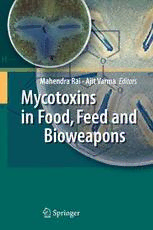
Mycotoxins in Food, Feed and Bioweapons PDF
Preview Mycotoxins in Food, Feed and Bioweapons
Mycotoxins in Food, Feed and Bioweapons Mahendra Rai Ajit Varma l Editors Mycotoxins in Food, Feed and Bioweapons Editors MahendraRai,Ph.D. ProfessorDr.AjitVarma ProfessorandHead DirectorGeneral BiotechnologyDepartment AmityInstituteofMicrobialTechnology SGBAmravatiUniversity AmityUniversityUttarPradesh Amravati-444602 &ViceChairman Maharashtra AmityScience,Technology&InnovationFoundation India BlockA,AmityCampus,Sector125 [email protected] Noida,UP201303 India [email protected] ISBN978-3-642-00724-8 e-ISBN978-3-642-00725-5 DOI:10.1007/978-3-642-00725-5 SpringerHeidelbergDordrechtLondonNewYork LibraryofCongressControlNumber:2009929167 #Springer-VerlagBerlinHeidelberg2010 Thisworkissubjecttocopyright.Allrightsarereserved,whetherthewholeorpartofthematerialis concerned,specificallytherightsoftranslation,reprinting,reuseofillustrations,recitation,broadcasting, reproductiononmicrofilmorinanyotherway,andstorageindatabanks.Duplicationofthispublication orpartsthereofispermittedonlyundertheprovisionsoftheGermanCopyrightLawofSeptember9, 1965,initscurrentversion,andpermissionforusemustalwaysbeobtainedfromSpringer.Violationsare liabletoprosecutionundertheGermanCopyrightLaw. Theuseofgeneraldescriptivenames,registerednames,trademarks,etc.inthispublicationdoesnotimply, evenintheabsenceofaspecificstatement,thatsuchnamesareexemptfromtherelevantprotectivelaws andregulationsandthereforefreeforgeneraluse. Coverdesign:WMXDesignGmbH,Heidelberg,Germany Printedonacid-freepaper SpringerispartofSpringerScience+BusinessMedia(www.springer.com) Foreword Mycotoxins are a large and varied group of mold-secondary metabolites. Their commonfeaturesarethattheyareallproducedbyfungi,andthattheyallhavetoxic effectsagainstvertebratesandotherorganisms.Nevertheless,itishardtogeneral- izeaboutmycotoxins.Theyaremadebydifferentbiosyntheticpathways,andthey have an extremely wide range of pharmacological effects. Human beings and domestic animals come in contact with them by different routes (diet, dermal contact, respiration); the fungi which produce them occupy different ecological niches, and they span a wide range of important fungal genera (Aspergillus, Fusarium, Penicillium and many others). Even the definition of “mycotoxin” is a matterofdispute.Noteveryoneincludeszearalenoneandtheyeastkillertoxins— both discussed in this monograph — within the mycotoxin rubric. Zearalenone, although biologically potent as an estrogen mimic, is not particularly toxic in the traditionalsenseofcausingdeath.Yeastkillertoxinsareneithermoldmetabolites nor viewed as particularly poisonous environmental agents. They are best known for their use in biotyping and as immunological derivatives. Nevertheless, while expertsdifferaboutwhichcompoundsshouldbeclassifiedappropriatelyasmyco- toxins, everyone agrees that mycotoxins impose an enormous economic burden. Theyfrequentlyrenderagriculturalproduceunusable,theyinflictuntoldsuffering and death on human and animal populations, and their regulation has become a majorfactorininternationaltrade. Mycotoxins have been reviewed many times, but this monograph touches on freshterritory,including(1)newanalyticalmethodsfordetection,(2)theadoption of an ancient Mexican process for detoxification of aflatoxins, (3) mycotoxin management in Ireland, Lithuania and South America, (4) mycotoxin reduction throughplantbreedingandintegratedmanagementpractices,and(5)anoverviewof naturalaflatoxininhibitorsfrommedicinalplants.Theforthcomingchaptershigh- light recent research findings, with emphasis on aflatoxins, ochratoxins, selected trichothecenes, and zearalenone. Aflatoxin-like gene clusters are discussed, as are aspects of sclerotial development in Aspergillus flavus and A. parasiticus. Of particular interest are the chapters on the weaponisation of mycotoxins and the potentialforuseofmycotoxinsasagentsofbioterrorism.Similarly,thediscussion v vi Foreword ofconjugated(“masked”)mycotoxinderivativesisatopicrarelyencounteredinthe mycotoxinliterature. This book will update readers on several cutting-edge aspects of mycotoxin research,andwillstimulatenewthinkingontheneedtodeveloptherapeuticaswell aspreventativeinterventionsforloweringtheirtoxicologicalmenace.Withincreas- ing globalization and world trade, the mycotoxin problem will grow only more significantincomingyears. Professor(Dr.)J.W.Bennett DepartmentofPlantBiologyandPathology SchoolofBiologicalandEnvironmentalSciences RutgersUniversity NewBrunswick,NewJersey08901,USA [email protected] Preface Mycotoxins are produced by fungi as secondary metabolites in cereals and food. Thesechemicalcompoundsarelipid-soluble,andeasilyabsorbedbytheintestines, airwaysandskin.Inrecentyears,theriskduetomycotoxinsisincreasingparticu- larly in foodand feed, resulting indeterioration ofhuman andanimal health.The contamination of food by mycotoxins has become a matter of great concern, as these are responsible for many lethal diseases like cancer and other chronic diseases. According to an estimate, 25% of the world’s crops are affected by toxigenic fungi. Mycotoxins have become part of the food chain. Reduction of thesetoxinsrequiresamultifacetedapproach,includingactionbyfarmers,govern- mentagencies,foodprocessorsandscientists.Therearemorethan400compounds knownasmycotoxins.Mycotoxinsreleasedbymoldsoccurringindamagedbuild- ingsinanindoorenvironmentarealsohazardoustohealth.Amongthese,aflatoxins produced by Aspergillus flavus are well-known in the world. Other mycotoxins includecitrinin,ochratoxin,patulin,trichothesene,andzearalenone. Anotherareaofmycotoxinswhichwarrantsattentionistheiruseinbioweapons. The T-2 mycotoxins (trichothecene), usually produced by Fusarium species, are usedasbioweaponsduringwar,sincemold-toxinsarecheap,easytoaccessandcan beappliedforasmallgroupofenemies.Otherfungiwhichproducetrichothecens are Myrothecium Trichoderma, and Stachybotrys. As a matter of fact, it is very importanttounderstandthesymptomsofmycotoxininfectionforrapididentifica- tion,inordertoinactivateitsill-effectsonpatients. Thereisapressingneedforstrictregulationsinordertomanagemycotoxins.A strategy should be developed collectively by farmers, scientists, clinicians and policy-makers to combat the mycotoxin menace for a sustainable future. In fact, themycotoxinmenacetohumanbeingsandanimalshasgeneratedtheideatobring out this book, in which efforts have been made to gather diverse topics on myco- toxinwithup-to-dateinformation. Broadly divided into three sections and 22 chapters, this book is aimed at the diverse backgrounds of students and researchers. Section I focuses on general topics, Section II concentrates on the role of mycotoxins in agriculture and food, andSectionIIIdealswithtoxicityandtheuseofmyotoxinsasbioweapons. vii viii Preface The book would be essential reading for mycologists, agriculture scientists, clinicians, fungal technologists, microbiologists, both plant and human patholo- gists,pharmacologistsandforensicscientists,whomaybeinterestedtounravelthe mysteriesoftoxicityofmycotoxinsinfood,feedandbioweapons. WethankDr.JuttaLindenborn,Springer,Heidelberg,Germanyforherpatience and suggestions. MKR is thankful to Professor Dr. Gyo¨rgy Ja´nos Ko¨vics, Head, PlantProtectionDepartment,DebrecenAgricultureUniversity,Debrecen,Hungary for providing necessary facilities for editing and finalizing the manuscript during myvisittohisinstitute.Further,MKRwishestothankAlkaKarwa,AniketGade, Ravindra Ade, Avinash Ingle, Dnayeshwar Rathod, Vaibhav Tiwari, Alka Yadav andJayendraKesharwaniforhelpinediting. April2009 MahendraRai Amravati,Maharashtra AjitVarma andNoida,UttarPradesh Contents PartI BiologyandBiotechnology 1 ArtificialSystemsforMolecularRecognitionofMycotoxins ............. 3 ClaudioBaggiani,LauraAnfossi,andCristinaGiovannoli 2 MolecularMechanismofDetectionofAflatoxins andOtherMycotoxins ...................................................... 21 Avishay-AbrahamStark 3 TheDestructionofAflatoxinsinCornby‘‘Nixtamalizacio´n’’ ........... 39 DoralindaGuzma´n-de-Pen˜a 4 MycotoxigenicFungionBaledGrassSilageinIreland .................. 51 MartinO’Brien 5 Aflatoxin-likeGeneClustersandHowTheyEvolved .................... 65 KennethC.EhrlichandJiujiangYu 6 AflatoxinBiosynthesisandSclerotialDevelopmentinAspergillus flavusandAspergillusparasiticus .......................................... 77 Perng-KuangChang 7 InteractionBetweenAflatoxinB andOtherRiskFactors 1 inHepatocarcinogenesis .................................................... 93 MichaelC.Kew 8 ZearalenoneanditsDerivatives:KnownToxinsinNewAspects .... 113 PiotrGolinski,AgnieszkaWaskiewicz,andKarolinaGromadzka 9 Zearalenone:UndesirableSubstance ................................... 131 MaciejGaje˛cki,MagdalenaGaje˛cka,EwaJakimiuk,ŁukaszZielonk, andKazimierzObremski ix x Contents PartII AgricultureandFood 10 MycotoxinsinLithuanianCerealsandGrainProducts .............. 147 AudroneMankeviciene 11 ControlofMycotoxinContaminationinCerealsbyBreeding ...... 163 A´kosMesterha´zy 12 FusariumandFumonisinsinMaizeinSouthAmerica ............... 179 AdrianaM.Torres,MariaL.Ramirez,andSofiaN.Chulze 13 PreventionandManagementofMycotoxinsinFoodandFeed ..... 201 BulentKabak 14 MycotoxigenicFungiandMycotoxinsinAnimalFeedinSouth AmericanCountries ..................................................... 229 CarinaElizabethMagnoli,LiliaRene´eCavaglieri,CarlosAlberto daRochaRosa,andAnaMar´ıaDalcero PartIII ToxicologyandBioweapons 15 Nivalenol:TheMycology,Occurrence,Toxicology,Analysis andRegulation ........................................................... 253 YoshikoSugita-KonishiandTakashiNakajima 16 YeastKillerToxinsTechnologyTransfer ............................. 275 WalterMagliani,StefaniaConti,LauraGiovati,andLucianoPolonelli 17 TrichothecenesasToxinandBioweapons: PreventionandControl .................................................. 291 AvinashIngle,AjitVarma,andMahendraRai 18 RiskAssessmentofOchratoxinA(OTA) .............................. 307 DianaRingotandAbaloChango 19 NaturalAflatoxinInhibitorsfromMedicinalPlants .................. 329 MehdiRazzaghi-Abyaneh,MasoomehShams-Ghahfarokhi, Mohammad-BagherRezaee,andShoheiSakuda 20 TheMyco-AgentsofBioterrorism ..................................... 353 NathanP.CharltonandChristopherP.Holstege 21 TheWeaponisationofMycotoxins ..................................... 367 RobertRussellMonteithPatersonandNelsonLima Contents xi 22 MaskedMycotoxinsandMycotoxinDerivativesinFood: TheHiddenMenace ..................................................... 385 ChiaraDall’Asta,GianniGalaverna,ArnaldoDossena,StefanoSforza, andRosangelaMarchelli Index ........................................................................... 399
